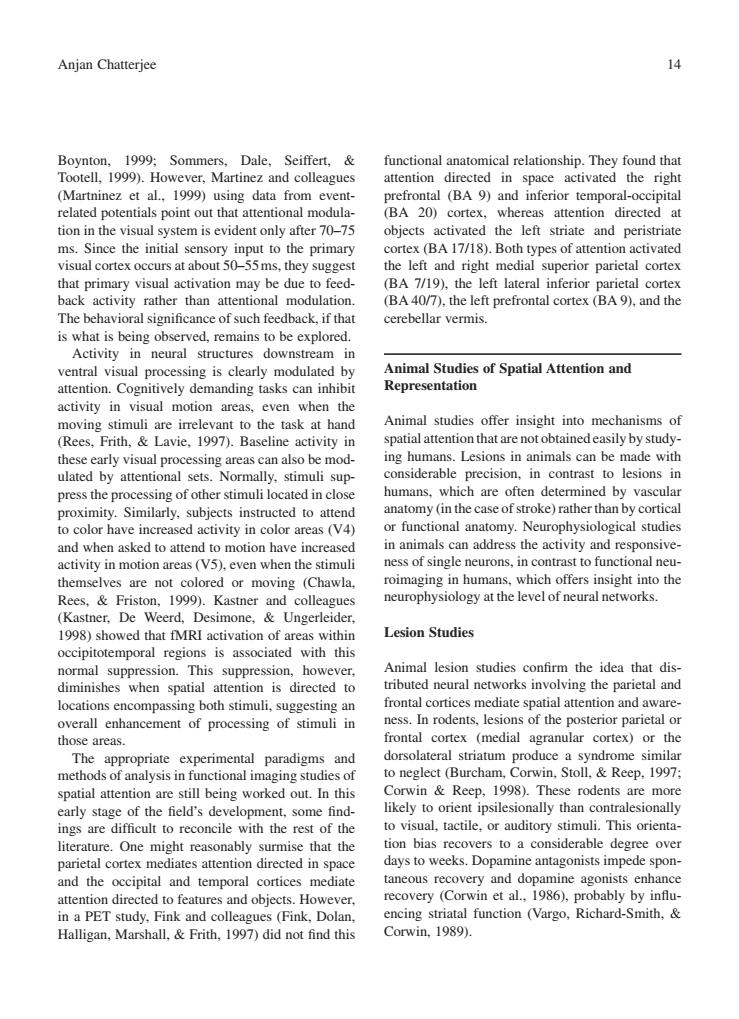正在加载图片...

Anian chatteriee Boynton, 1999:Somme Dale Seiffert functional anatomical relationshin They found that Tootell.1999).However.Martine and colleague attention directed in space activated the right (Martnine? et al 1999)us data fron ontal (BA 9)and inferior te ral-occip tal related pote tials point out tha whereas attenti directed at tion in the visual tem is evident only after 70-75 istriate Since the initia th e primar the e(). nd ypes of pa t latera a cortex 9).and h beha cereb ella vermis wha Ac in structure Animal Studies of Spatial attention and ng is emanding Representation activity motion area whe moving st muli are irrel evant to the task Animal studies offer insight into mechanisms of (Rees Frith,& Lavie,1997).Baselin spatial attention that a sily by study ade w early visual processing areas can also be mod Lesioaenotobtai mals can be n ulated by attentional sets.Normally,stimuli sup ons ined press the processing of other stimuli located in close proximity.Similarly.subjects instructed to atten my (in the of stroke) athe to color have increased activity in color areas (V4 nal an and when asked to attend to motion have increase activity in motion areas (V5).even when the stimul single the activi neurons, themselves are not colored or moving (Chawla roimaging offers insigh nto the Rees,Friston,1999).Kastner and colleagues neurophysiology at the level of neural networks (Kastner.De Weerd.Desimone.Ungerleider 1998)showed that fMRI activation of areas within Lesion Studies occipitotemporal regions is associated with this normal suppression.This suppression.however diminishes when spatial attention is directed to locations encompassing both stimuli.suggesting an overall enhancement of processing of stimuli in In rodents ol the postenor parietal those areas onta cortex (medial agranular cortex)or the exnerimental paradigm and dorsolateral striatum produce a syndrome simila to neglect (Burcham.Corwin.Stoll.Reep.1997 spatial attention are still being worked out.In this Corwin Reep,1998).These rodents are more early stage of the field's development.some find likely to orient ipsilesionally than contralesionally ings are difficult to reconcile with the rest of the to visual.tactile.or auditory stimuli.This orienta- literature.One might reasonably surmise that the tion bias recovers to a considerable degree over days to weeks.Dopamine antagonists impede spon and the occipital and temporal cortices taneous recovery and dopamine agonists enhance nd obiects Ho recovery (Corwin et al.,1986).probably by influ in a PET study.Fink and colleas (Fink.Dolan encing striatal function(Vargo,Richard-Smith,& Halligan,Marshall,&Frith,1997)did not find this Corwin.1989). Boynton, 1999; Sommers, Dale, Seiffert, & Tootell, 1999). However, Martinez and colleagues (Martninez et al., 1999) using data from eventrelated potentials point out that attentional modulation in the visual system is evident only after 70–75 ms. Since the initial sensory input to the primary visual cortex occurs at about 50–55ms, they suggest that primary visual activation may be due to feedback activity rather than attentional modulation. The behavioral significance of such feedback, if that is what is being observed, remains to be explored. Activity in neural structures downstream in ventral visual processing is clearly modulated by attention. Cognitively demanding tasks can inhibit activity in visual motion areas, even when the moving stimuli are irrelevant to the task at hand (Rees, Frith, & Lavie, 1997). Baseline activity in these early visual processing areas can also be modulated by attentional sets. Normally, stimuli suppress the processing of other stimuli located in close proximity. Similarly, subjects instructed to attend to color have increased activity in color areas (V4) and when asked to attend to motion have increased activity in motion areas (V5), even when the stimuli themselves are not colored or moving (Chawla, Rees, & Friston, 1999). Kastner and colleagues (Kastner, De Weerd, Desimone, & Ungerleider, 1998) showed that fMRI activation of areas within occipitotemporal regions is associated with this normal suppression. This suppression, however, diminishes when spatial attention is directed to locations encompassing both stimuli, suggesting an overall enhancement of processing of stimuli in those areas. The appropriate experimental paradigms and methods of analysis in functional imaging studies of spatial attention are still being worked out. In this early stage of the field’s development, some findings are difficult to reconcile with the rest of the literature. One might reasonably surmise that the parietal cortex mediates attention directed in space and the occipital and temporal cortices mediate attention directed to features and objects. However, in a PET study, Fink and colleagues (Fink, Dolan, Halligan, Marshall, & Frith, 1997) did not find this functional anatomical relationship. They found that attention directed in space activated the right prefrontal (BA 9) and inferior temporal-occipital (BA 20) cortex, whereas attention directed at objects activated the left striate and peristriate cortex (BA 17/18). Both types of attention activated the left and right medial superior parietal cortex (BA 7/19), the left lateral inferior parietal cortex (BA 40/7), the left prefrontal cortex (BA 9), and the cerebellar vermis. Animal Studies of Spatial Attention and Representation Animal studies offer insight into mechanisms of spatial attention that are not obtained easily by studying humans. Lesions in animals can be made with considerable precision, in contrast to lesions in humans, which are often determined by vascular anatomy (in the case of stroke) rather than by cortical or functional anatomy. Neurophysiological studies in animals can address the activity and responsiveness of single neurons, in contrast to functional neuroimaging in humans, which offers insight into the neurophysiology at the level of neural networks. Lesion Studies Animal lesion studies confirm the idea that distributed neural networks involving the parietal and frontal cortices mediate spatial attention and awareness. In rodents, lesions of the posterior parietal or frontal cortex (medial agranular cortex) or the dorsolateral striatum produce a syndrome similar to neglect (Burcham, Corwin, Stoll, & Reep, 1997; Corwin & Reep, 1998). These rodents are more likely to orient ipsilesionally than contralesionally to visual, tactile, or auditory stimuli. This orientation bias recovers to a considerable degree over days to weeks. Dopamine antagonists impede spontaneous recovery and dopamine agonists enhance recovery (Corwin et al., 1986), probably by influencing striatal function (Vargo, Richard-Smith, & Corwin, 1989). Anjan Chatterjee 14